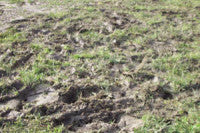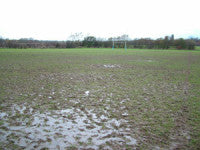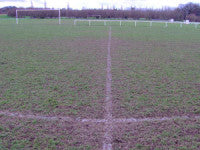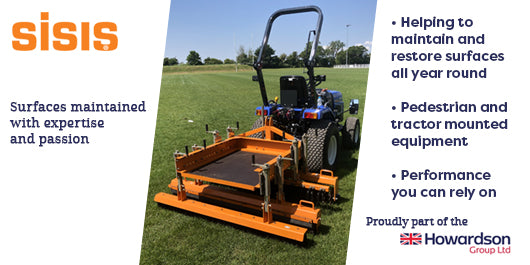Must we accept potato patch football pitches?
Must we accept potato patch football pitches?
By Gordon Jaaback

There has been much research in sports pitch construction and drainage. Unfortunately, however, much of this work is costly and is only currently undertaken on superior football pitches or individual private grounds.
Dilemma
There are thousands of football pitches plagued with drainage problems and little is done to overcome the shortfalls. The costs to repair and maintain have not been considered in the annual maintenance budgets and authorities face the difficult task of trying to produce acceptable pitches with inadequate funds. With the disastrous condition of pitches their use is restricted and children are compelled to other activities or using completely unsuitable facilities in search of recreation.
Monitoring the maintenance programme is seldom undertaken and often the main limiting factors are not properly addressed. Essential yet simple procedures are left out of the programme and soon a chain of factors contribute to the steady deterioration of the facility.
Looking at the facts, firstly, the great majority of pitches have been developed on heavy clay soils which dominate the country. Secondly, the construction methods adopted have in many cases contributed to their downfall. Thirdly, there has been no appraisal of the essential needs in the annual maintenance programme to ensure the best playing surface possible on the pitches.
In recent years as a result of lottery grants the authorities Sport England and the Football Foundation, to name a few, have published guide notes for proper construction and maintenance and provided funds for many deserving projects. Again though, regrettably the methods prescribed are well beyond the scope of any private or community organisation without these supplementary funds.
Drainage

· The control and diversion of surplus drainage water from the immediate pitch surround is a matter often neglected. High ground above a pitch must shed water run-off on to pitches and the construction of cut-off drains, often as a late effort to save the situation, seldom save the situation in the long-term. Swales or diverting mounds and associated deep pipe drains prevent any surface water run-off or underground water from reaching the pitch. This measure alone can account for a good many of the problems faced on wet pitches.
· The location of a permeable seam of gravel or depth of chalk can serve as a valuable means for water removal. The presence of a high water table is not usual on sports pitches but this has to be confirmed.
Sub-soil
A proper examination of the profile for the depth of a full two metres - or more where significant cut to fill procedures must be followed in construction - can reveal valuable information regarding the drainage in the lower layers.
· The application of gypsum and incorporation into the clay subgrade can considerably improve the drainage. In fact, the subsoil determines the drainage potential of the pitch and once the topsoil is in place its condition below the topsoil cannot be modified.
· The importance of properly ripping and scarifying the subsoil surface cannot be over emphasised.
· The preparation of the subsoil must be confined to dry weather conditions. Handling of any soil in wet conditions is damaging but preparation of a wet sub-base causes detrimental conditions that cannot be overcome.
Grading
The planning of the gradients can be a difficult task - especially on relatively level ground. With the inherent clay soils, wet winters with low evaporation rates, the surface condition easily becomes saturated.
· With topsoil in a saturated state and free water on or near the surface there is potential for water run-off provided there is sufficient gradient. From the playing perspective it is now well established that the cross-fall can be as much as 2.5% while the gradient in the direction of play can be as much as 1.25%. Even without these gradients a diagonal fall of 1.45% should be relatively easy to obtain and this minimum grade is essential if surface water run-off is to be possible.
· Associated with the gradient is the evenness of the grade. Depressions in a pitch with good gradients soon concentrate surface water bringing waterlogged conditions. The final grading of the pitch is probably the most important requirement in the completion of a football pitch. Today with laser equipment even grades can be easily attained and the requirement of no variation greater than 25mm from the proposed grade and no greater than 15mm over a 3m straight edge anywhere on the pitch is not an unreasonable specification requirement.
Maintenance

· Basic nutrient formulations and follow up nitrogen treatments are relatively inexpensive and yet can become vital in securing a good ryegrass cover in preparation for the winter season.
· Mowing should be frequent enough to maintain a density in the grass cover. The interval should not be a fixed period but rather in accordance with the vigour in growth.
· Though not common on football pitches the control of thatch is essential. Being able to hold much water, thatch can initiate water-logged conditions.
· Decompacting by vertidraining or vibrating tines (such as the 'eartdhquake') is essential with continual play and the increasing compaction that takes place in the top 150mm of the topsoil. There are also the cultural treatments of harrowing, rolling and divoting.
· Weed control is often neglected. Weeds encroach when the grass cover is limiting and conditions are suitable for their development. Apart from ensuring a good grass cover, annual weed spraying treatments can be essential in order to give the grass cover a better chance to develop an even and dense cover throughout.
· Earthworms too, can quickly impair the playing surface bringing muddy conditions. Chemical spray treatments to temporarily control the forming of worm casts are essential if a clean grass cover is to be maintained.
· Sand top-dressings help to consolidate slippery clay loam surfaces but are only really beneficial on an even grade where, as a layer, the sand conveys water run-off better than an unstable clay surface. As a treatment they are essential after secondary drainage installation.
Renovation
With the limited period between the end of the playing season and the start of the next, renovation measures have to be well planned and executed. Scarification, vertidraining, relevelling and overseeding must be completed before the hot summer is under way. Goalkeeping areas need special treatment especially decompaction. The correct application of a well balanced formulation of mineral nutrients too are essential to enable the pitch to recover and properly establish for the season ahead.
Summary
Sand construction or the installation of intensive drainage measures are costly means to ensure firm dry conditions throughout the wet winter period. However, sound basic methods of construction followed by timely simple treatments can help considerably to sustain satisfactory playing conditions throughout the winter. Without these essentials in place maintaining acceptable playing conditions throughout the wet winter months can be a hopeless task.
Gordon Jaaback BSc Agric
Consulting Agronomist & Project manager
Tel: (44) 1732 350351
By Gordon Jaaback

There has been much research in sports pitch construction and drainage. Unfortunately, however, much of this work is costly and is only currently undertaken on superior football pitches or individual private grounds.
Dilemma
There are thousands of football pitches plagued with drainage problems and little is done to overcome the shortfalls. The costs to repair and maintain have not been considered in the annual maintenance budgets and authorities face the difficult task of trying to produce acceptable pitches with inadequate funds. With the disastrous condition of pitches their use is restricted and children are compelled to other activities or using completely unsuitable facilities in search of recreation.
Monitoring the maintenance programme is seldom undertaken and often the main limiting factors are not properly addressed. Essential yet simple procedures are left out of the programme and soon a chain of factors contribute to the steady deterioration of the facility.
Looking at the facts, firstly, the great majority of pitches have been developed on heavy clay soils which dominate the country. Secondly, the construction methods adopted have in many cases contributed to their downfall. Thirdly, there has been no appraisal of the essential needs in the annual maintenance programme to ensure the best playing surface possible on the pitches.
In recent years as a result of lottery grants the authorities Sport England and the Football Foundation, to name a few, have published guide notes for proper construction and maintenance and provided funds for many deserving projects. Again though, regrettably the methods prescribed are well beyond the scope of any private or community organisation without these supplementary funds.
Drainage

· The control and diversion of surplus drainage water from the immediate pitch surround is a matter often neglected. High ground above a pitch must shed water run-off on to pitches and the construction of cut-off drains, often as a late effort to save the situation, seldom save the situation in the long-term. Swales or diverting mounds and associated deep pipe drains prevent any surface water run-off or underground water from reaching the pitch. This measure alone can account for a good many of the problems faced on wet pitches.
· The location of a permeable seam of gravel or depth of chalk can serve as a valuable means for water removal. The presence of a high water table is not usual on sports pitches but this has to be confirmed.
Sub-soil
A proper examination of the profile for the depth of a full two metres - or more where significant cut to fill procedures must be followed in construction - can reveal valuable information regarding the drainage in the lower layers.
· The application of gypsum and incorporation into the clay subgrade can considerably improve the drainage. In fact, the subsoil determines the drainage potential of the pitch and once the topsoil is in place its condition below the topsoil cannot be modified.
· The importance of properly ripping and scarifying the subsoil surface cannot be over emphasised.
· The preparation of the subsoil must be confined to dry weather conditions. Handling of any soil in wet conditions is damaging but preparation of a wet sub-base causes detrimental conditions that cannot be overcome.
Grading
The planning of the gradients can be a difficult task - especially on relatively level ground. With the inherent clay soils, wet winters with low evaporation rates, the surface condition easily becomes saturated.
· With topsoil in a saturated state and free water on or near the surface there is potential for water run-off provided there is sufficient gradient. From the playing perspective it is now well established that the cross-fall can be as much as 2.5% while the gradient in the direction of play can be as much as 1.25%. Even without these gradients a diagonal fall of 1.45% should be relatively easy to obtain and this minimum grade is essential if surface water run-off is to be possible.
· Associated with the gradient is the evenness of the grade. Depressions in a pitch with good gradients soon concentrate surface water bringing waterlogged conditions. The final grading of the pitch is probably the most important requirement in the completion of a football pitch. Today with laser equipment even grades can be easily attained and the requirement of no variation greater than 25mm from the proposed grade and no greater than 15mm over a 3m straight edge anywhere on the pitch is not an unreasonable specification requirement.
Maintenance

· Basic nutrient formulations and follow up nitrogen treatments are relatively inexpensive and yet can become vital in securing a good ryegrass cover in preparation for the winter season.
· Mowing should be frequent enough to maintain a density in the grass cover. The interval should not be a fixed period but rather in accordance with the vigour in growth.
· Though not common on football pitches the control of thatch is essential. Being able to hold much water, thatch can initiate water-logged conditions.
· Decompacting by vertidraining or vibrating tines (such as the 'eartdhquake') is essential with continual play and the increasing compaction that takes place in the top 150mm of the topsoil. There are also the cultural treatments of harrowing, rolling and divoting.
· Weed control is often neglected. Weeds encroach when the grass cover is limiting and conditions are suitable for their development. Apart from ensuring a good grass cover, annual weed spraying treatments can be essential in order to give the grass cover a better chance to develop an even and dense cover throughout.
· Earthworms too, can quickly impair the playing surface bringing muddy conditions. Chemical spray treatments to temporarily control the forming of worm casts are essential if a clean grass cover is to be maintained.
· Sand top-dressings help to consolidate slippery clay loam surfaces but are only really beneficial on an even grade where, as a layer, the sand conveys water run-off better than an unstable clay surface. As a treatment they are essential after secondary drainage installation.
Renovation
With the limited period between the end of the playing season and the start of the next, renovation measures have to be well planned and executed. Scarification, vertidraining, relevelling and overseeding must be completed before the hot summer is under way. Goalkeeping areas need special treatment especially decompaction. The correct application of a well balanced formulation of mineral nutrients too are essential to enable the pitch to recover and properly establish for the season ahead.
Summary
Sand construction or the installation of intensive drainage measures are costly means to ensure firm dry conditions throughout the wet winter period. However, sound basic methods of construction followed by timely simple treatments can help considerably to sustain satisfactory playing conditions throughout the winter. Without these essentials in place maintaining acceptable playing conditions throughout the wet winter months can be a hopeless task.
Gordon Jaaback BSc Agric
Consulting Agronomist & Project manager
Tel: (44) 1732 350351
Article Tags:
Football

